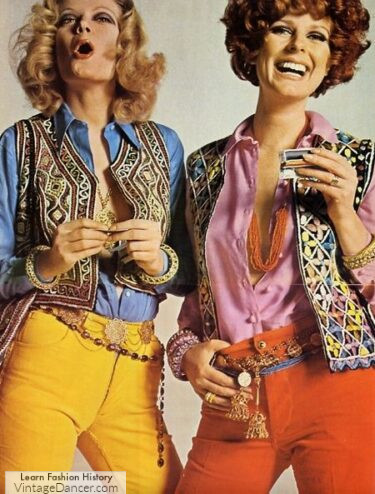The hippie counterculture of the 1960s revolutionized fashion with its distinctive “anything goes” aesthetic. Rejecting mainstream consumerism, hippies embraced individuality, self-expression, and a back-to-nature philosophy, resulting in a unique style that continues to inspire today. This style, characterized by loose silhouettes, natural fabrics, and handcrafted details, became a powerful symbol of peace, love, and freedom.
Hippie fashion was a direct rebellion against the structured and materialistic “mod” style prevalent in the mid-60s. Instead of sleek and tight clothing, hippies favored loose, unstructured garments that allowed for freedom of movement and a rejection of societal norms. Designer labels were irrelevant; clothing was meant to reflect the individual, not their status. Customization was key, with hippies often personalizing their clothes through tie-dyeing, painting, embroidery, patches, and the addition of beads, studs, and pins.
Accessories played a crucial role in completing the 60’s hippie look. Bandanas, scarves, and an abundance of jewelry were worn by both men and women. Leather, hemp, and straw were popular materials for necklaces and bracelets, often adorned with beads, particularly “donkey beads.” Rings and bangles were also worn in excess, with costume jewelry favored over expensive pieces. Hats were a whimsical addition, ranging from oversized floppy hats for women to decorated cowboy hats or even women’s cloches for men. Belts were either thin strips of fabric or thick with large buckles.
Sunglasses were another essential accessory. Round or oversized plastic frames were the norm, with occasional novelty shapes like hearts or squares. Pastel-tinted lenses, particularly in pink, purple, blue, and yellow, were a defining feature of hippie sunglasses. While gradient lenses emerged in the mid-60s, they weren’t widely adopted by hippies until the early 70s.
Footwear was often optional, but when worn, practicality and comfort were prioritized. Boots and sandals, preferably in brown, were the most common choices. Gladiator sandals, lace-up canvas shoes, and moccasins were also popular. As the decade progressed, some hippies incorporated go-go boots and other mod-influenced footwear into their style. Towards the end of the 60s, earthy suede or leather shoes, often with Native American influences, became increasingly prevalent.
The feminist movement and the concept of “free love” fostered androgyny in hippie fashion. Women frequently wore men’s clothing, including oversized t-shirts, jackets, and work shirts, often transforming them into minidresses. Makeup was minimal, bras were optional, and grooming was understated. Smocked maxi dresses, A-line skirts, and wide-leg pants in light fabrics like cotton or linen, often featuring bright solids or ethnic prints, were also staples of women’s hippie attire.
The “Earth Mother” look, emphasizing natural beauty and sustainability, emerged within the hippie movement. Long, unstyled hair adorned with headpieces, minimal makeup, and flowing silhouettes created a peaceful and ethereal aesthetic. Natural fabrics in earthy tones and white were favored, and upcycled clothing made from scraps or repurposed materials became a common practice. Patchwork garments and dresses fashioned from bedsheets showcased the resourcefulness and creativity of hippie women.
For hippie men, simple was often the key. A shirt (optional) and casual pants were the standard uniform. T-shirts, turtlenecks, and slim-straight trousers in corduroy, cotton, or denim were common choices. As the psychedelic movement gained momentum, brightly colored pants and shirts with bold patterns became more prevalent. Eastern-inspired tunics, robes, and capes, often adorned with intricate prints, were also popular among men, reflecting the spiritual and philosophical influences within the hippie culture.
Military, workwear, and biker styles heavily influenced men’s hippie fashion. Leather jackets, denim jackets, field jackets, and work shirts provided ruggedness and durability. Work boots, especially cowboy boots, were favored footwear. Layering was a defining characteristic, with men often wearing multiple shirts, vests, and jackets. Accessories like beaded necklaces, headbands, and bracelets were common for men as well.
The 60’s hippie style was more than just clothing; it was a statement of individuality, a rejection of conformity, and an embrace of peace and love. The movement’s influence on fashion continues to resonate today, reminding us of the power of self-expression and the enduring appeal of a style born from a desire for change and a celebration of freedom.

